Goma is a buzzing border town in the eastern part of Africa’s biggest state; the Democratic Republic of the Congo. On the other side of the frontier is Gisenyi in Rwanda. This border isn’t easy to cross, but when you can do it, don’t skip the chance to get to know the town of Goma on your way to Virunga or Nyiragongo.
Goma is the capital of the province of Northern Kivu, on the Northern shores of the Lake Kivu. Further east in this province there has been (and still is, just in a minor scale) ongoing conflicts between guerilla groups and government troops. So, unfortunately, that area is still mostly a no-go for travelers. But it’s still perfectly safe to visit Goma.
Goma is only about 20 kilometers away from the most active volcano in the world – Nyiragongo. During the last big eruption of Nyiragongo in 2002, the lava flow reached all the way to Goma. A fissure 13 km long opened in the southern flank of the volcano and reached the outskirts of Goma in a few hours.
Lava streamed from three spatter cones at the end of the fissure and flowed in a stream of 200 to 1000 meters wide and 2 meters deep through Goma. During the eruption, 400 000 people were evacuated from the city across the Rwandan border to Gisenyi. The lava also covered the northern end of the runway of Goma’s International Airport and reached all the way to Lake Kivu.
You can still see the remnants of the lava, big piles of volcanic rock, everywhere around Goma.
But not all of it is a useless waste; people have even used it to build fences.
Goma Tour is Something to Remember
In the center of a traffic circle, just across the border with Rwanda, stands an enormous, golden-colored statue of a man with a chukudu.
It was quite a communistic-like statue in its grandiloquent way – a pretty odd feature to see in the middle of Africa. Made me feel like that I suddenly wasn’t in Africa anymore.
You can take all walking Goma tour, too, if you want. However, it may be a bit riskier sometimes. So, depending on your guide, the areas you’re going to visit, and the gear you bring with you, I’d consider whether to take a tour in a car or by foot.
Most of the time of our Goma tour we were touring around in a car, accompanied by our guide, Tresor, and our driver. Tresor was telling us comprehensive details about Goma while we tried to take some decent photographs from the open window.
The reception wasn’t always friendly. Sometimes we saw unsatisfied expressions when people noticed my camera. And on the occasions when we were on the streets, I saw that Tresor was looking around efficiently all the time.
I almost said to him that I could take care of myself just fine, but decided not to, and instead, I concentrated on shooting some decent frames.
But people’s faces weren’t all gloomy, sometimes we also confronted some warm smiles and pure interest.
Chukudu – Eastern Congo’s Traditional Transport
The boy in the picture below is riding a chukudu. The chukudu is a two-wheeled vehicle, handmade out of wood and used for transporting various freight in the east of the Democratic Republic of Congo. Chuduku is a native transporter of the eastern Congo.
The chukudu usually has a bulky frame, two small wheels (often of wood, sometimes wrapped with rubber), handlebars, and a pad for the rider to place their knee on while propelling the vehicle with their leg. On a downhill, the rider stands on the deck like a kick scooter. On the flat ground, the rider can put one knee on the deck and push the ground by the other foot.
In 2008, chukudus were selling for as much as US$100 with a cost of materials of nearly US$60. Also, in 2014 they cost $50 to $100 and were used to earn up to $10 per day, in an area where most people live on less than $2 per day. So, they aren’t cheap, but they make lives much easier for the poor people of the Democratic Republic of the Congo (DRC).
While chukudus rule on the lava-torn, bumpy, and muddy roads of the outskirts areas, scooters swirl on the paved roads of Goma. Motorcycle taxis seemed to be the top mean of transport for the local people, and there was a guy on a scooter with an extra helmet on their hand on almost every corner.
Around the NGOs and the Army Headquarters in Goma
Outside of the center of Goma, there are countless houses behind tall fences, topped with barbed wire. Most of them are the headquarters of different NGOs. We drove by the HQ of the “Doctors Without Borders,” among others.
However, all of the buildings weren’t of NGOs. Further on the outskirts, there were also many military outposts. Some of them were of the UN (part of the MONUSCO project), and some were of the Congolese Army.
The presence of soldiers was imminent in Goma. I remember when we once stopped by in a local shop to buy some more water and all of a sudden, three UN soldiers popped in – in full combat gear. I didn’t quite know which one to feel; secure or unsafe.
On the other hand, it made me feel more secure but then again, the presence of the UN military made it crystal-clear that they were there for a reason.
Stopping By at the Harbor Area of Goma
We also drove by the Goma’s harbor area, which is usually one of the shadiest areas in any city, in any town, anywhere in the world.
Here in Goma, it seemed pretty quiet, but the general atmosphere in the area right beside the harbor seemed like a place I wouldn’t necessarily want to wander in alone.
After our Goma tour, we went to grab some cold beers. Our guide, Tresor, and Dan, our local tour manager, took us to a local bar made in a small shack-like house – a place we never would’ve found by ourselves. We had a good time sharing a drink, and in the end, visits like these are some of the most interesting ones to have during your travels.
You can stop for a day or two in Goma on your way to climb the volcano Nyiragongo or to see the mountain gorillas of the DRC. But if you ever have a chance to go to Goma; go! It will be an experience to remember.
UPDATE: Unfortunately, the Virunga National Park and Mount Nyiragongo are now closed to tourists at least to the end of 2018!
But you can still go to visit Goma and other parts of the Democratic Republic of the Congo and taking a Goma tour will still make you see a bit more original African city.
PIN THIS STORY!
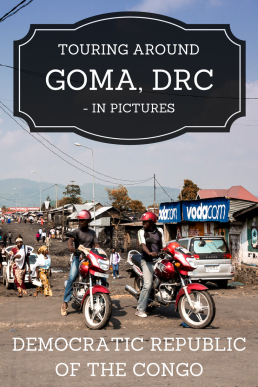
You May Also Like to Read:
Sailing Through the Explosive Lake Kivu in Rwanda
Sail through the bewitching Lake Kivu, a killer lake that could explode any time killing millions. The scenic journey from Gisenyi to Kamembe lingers between the borders of Rwanda and DRC, passing rural villages and uninhabited islets.
Tracking Rhinos on Foot in Uganda
Would you dare to track down rhinos on foot? We followed a ranger to the thick Ugandan bush to see our first white rhinos from zero distance.
Meeting the Giants of the Forest – Gorilla Trekking in Bwindi Impenetrable Forest, Uganda
How is it like to meet the endangered mountain gorillas of Bwindi Impenetrable Forest in Uganda? How to book and what to bring? Read on!
Nyiragongo Volcano Trek: How to Hike to Active, Fire-Spitting Volcano in Congo DR
Take part in our grueling hike into the mouth of Hell! Nyiragongo volcano in Congo DR boasts the world’s biggest active lava lake.


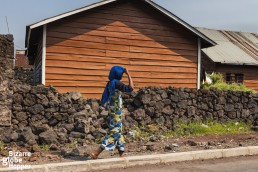
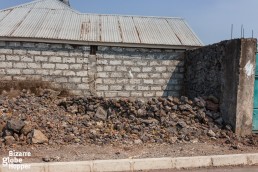
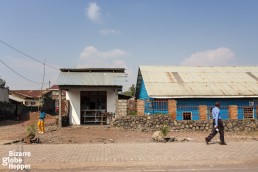
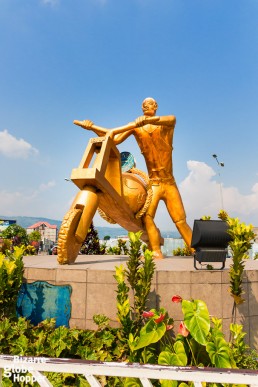
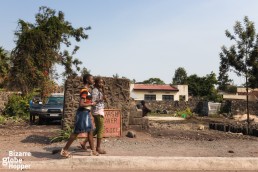
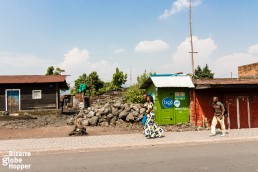
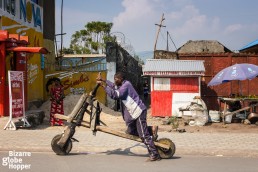
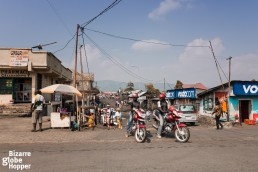
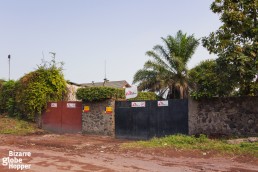
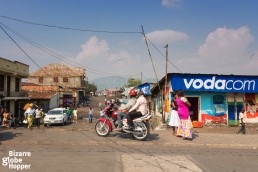
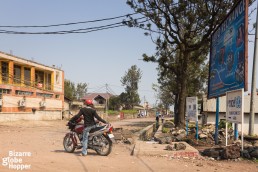
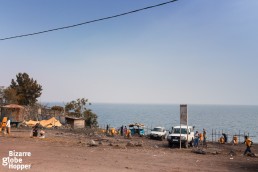
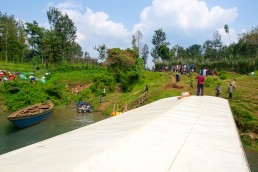
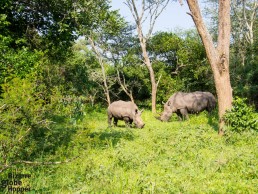
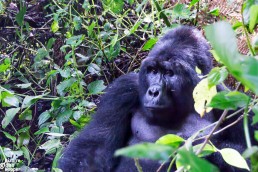
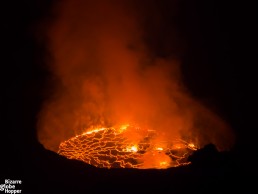
I have been living in Goma, DRC for 5 years now. I have seen this small town develop into a pretty decent place from scratches within 5 years. No doubt the arrival of UN H/Q from Kinshasa to Goma had a big impact. The airport became international with 4 Ethiopian flights per week. There is a decent ‘Jeffery Salon’ at the Goma Airport for the comfort of the passengers. Recently Serena has bought a cool place facing Lake Kivu to complete as their hotel in Goma. This would be a big boost for tourism. Though Virunga Park is closed for the whole of 2018, but Congo has a lot more to offer than only Virunga.
Hi, Jeffery. Nice to hear that tourism is developing in the DRC and new plans are thriving. Lake Kivu is a great place for a new lodge, so I hope that that project will proceed as planned. Virunga is a big part of DRC’s tourism, but sure there’s so much more to DRC than just Virunga. We’d also love to come back to the DRC someday and see more of the country! 🙂
Hey! Great info, thanks for sharing. Did you have to pay a photography license? What did your guides think about the license, was it realistic or did they not care?
Hi, Ross, and thanks so much, glad to know that you enjoyed the pictures. We didn’t have to pay for a photography license. Are you heading to the DRC soon?
Thanks so much for sharing your photos & story! These are the best travel experiences, when you can get away from the tourist circuit and get a glimpse of what day-to-day life is like in a place that you often don’t hear about in other blogs and in the news.
Hi, Brianne, and thanks for stopping by! Glad to know that you enjoyed the post. 🙂 You’re absolutely right – the best travel experiences are the ones when you get off from the most crowded tourist destinations and wander off to the more unknown territories. 😉
This is super cool! It’s one of the much less visited places making it even more exciting to read about. Very cool to read about.
Unfortunately though Virunga NP is closed for whole of 2018, we have finally been able to break the shackles by offering Kahuzi Biega gorilla trekking, waterfalls, chimps sanctuary, Congo River journey, Domaine de Chasses with lots of animals and Okapi, well protected by the ICCN’s Park Rangers. And yes, Congo is a huge country with 95% areas very safe and enjoyable, and that is improving.
Then of course we mix Rwanda, Uganda and Burundi to give a real African experience.
Thanks, Megan! Yes, it still is one of the much less visited places, even though DRC is such a huge country with a lot to offer. There are also so many other national parks beside the famous Virunga, so I hope that people would find these places, too.